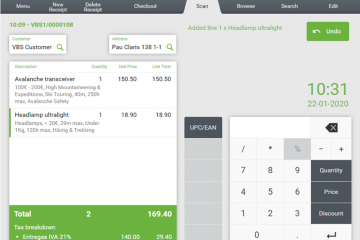User Experience: What Are the Real Benefits of a Web-based POS?

Deployment
Traditional stand-alone POS systems need specific hardware, or at least a specific operating system and require an installation process. Any update requires the terminal to be online, but the POS system must be stopped. Retailers seldom welcome a call from their IT support staff. No shop managers like to stop selling for 20 minutes for an IT upgrade.
When a terminal breaks down, the POS system must be installed on the new hardware and the local database must be restored, or regenerated. This process can take up to one day, providing spare hardware is available.
The story is very different with a Web-based POS. The Openbravo WebPOS requires no physical installation; the server distributes the upgrades automatically, and it takes only a few minutes to activate a new terminal. When a piece of hardware breaks down, a shop assistant can grab any smartphone, tablet or computer lying around and restart sales in a few minutes. The consumer may even not notice any delay.
Operational disruptions
Per one hundred terminals, 20 minute upgrades can account for four days of technician work, and sales that cannot be processed. Without remote access, if a technician needs to go shop by shop, the cost increases a hundred fold.
Out of a hundred terminals, one or two will break down per month. Big retailers have automated the installation of their POS system, but it may take 1 or 2 days to ship the new equipment to the shop.
Web-based POS upgrades are available from the deployment server, and create no downtime in shops. There is no installation in a shop, just 1 or 2 minutes of activation.
Training
A traditional client-server POS system, or character mode POS, has limited space and components. Relying on codes, it is often difficult for new employees to get used to them.
A well designed Web-based POS makes use of touch-friendly components. The Openbravo WebPOS gives immediate access to the most common features. Fully graphic and responsive, it is intuitive and easy to use. Only advanced features are available in menus. Training is eventually not necessary. Shop assistants are operational in less than an hour. A training mode makes the system itself the trainer.
First level support
Stand-alone POS systems use synchronisation to centralise sales data, stocks, customers, and to update product and promotion information. Synchronisation is a bulk process, which means a day’s worth of sales and other updates. For different reasons, this process fails from time to time. Very often because of an unstable connection. A bulk synchronization does not suffer from interruptions.
In that case, one day´s worth of sales data from one terminal is not consolidated. New products are not available in the POS system, stock is unavailable, and new customers are missing.
A Web-based POS uses constant synchronization. When the shop internet connectivity is down, a few sales are stored, together with their customer records. Sales, stock updates, and customers are synchronised when the shop comes back online. Sending transactions one by one is reliable even with unstable connections.
For every hundred terminals, 2 to 5 synchronisations may fail on any given day. A member of technical support staff spends half to a full day fixing this problem. With the Openbravo Commerce Suite, retailers have access to real-time sales and stock information from all their shops, with a few minutes delay in case of connection issues. Besides that, a hundred terminals will create 2 to 5 individual sales to recycle per week. These will require half an hour to fix and recycle.
The benefits of Web-based POS software scale upwards with the number of terminals. An efficient technical support team can manage more shops. and the availability of services in shops increases. Retailers can further take advantage of all the real-time information, for stock optimisation, and real-time pricing and promotion adjustment.




No Comment